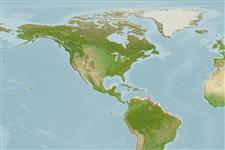Bivalvia |
Venerida |
Cyrenidae
Environment: milieu / climate zone / ระดับความลึก / distribution range
นิเวศวิทยา
. Tropical
Western Central Atlantic: Southern Caribbean and northern South America.
Length at first maturity / ขนาด / Weight / Age
วัยเจริญพันธุ์: Lm ? range ? - ? cmCommon length : 4.0 cm TL เพศผู้/กระเทย; (อ้างอิง 344)
Shell outline subtriangular, as high as long, inflated, heavy, slightly pointed posteriorly. Sculpture of well-defined concentric threads. Hinge with 3 cardinal teeth situated under umbo; 1 anterior and 1 posterior lateral tooth. Lateral teeth smooth. Ligament long, narrow. Periostracum with minute scales, fuzzy. Colour: externally cream-white, sometimes tinged with purple or grey, internally white often stained with purple and frequently with darker radial stripes at both ends; periostracum pale or dark brown.
Infaunal in mud or sandy-mud in estuaries, mangrove swamps and coastal lagoons (Ref. 344).
Life cycle and mating behavior
วัยเจริญพันธุ์ | การสืบพันธุ์ | การวางไข่ | Eggs | ความดกของไข่ | Larvae
Members of the class Bivalvia are mostly gonochoric, some are protandric hermaphrodites. Life cycle: Embryos develop into free-swimming trocophore larvae, succeeded by the bivalve veliger, resembling a miniature clam.
Leal, J.H. 2003 Bivalves. p. 25-98. In Carpenter, K.E. (ed.). The living marine resources of the Western Central Atlantic. Volume 1: Introduction, molluscs, crustaceans, hagfishes, sharks, batoid fishes, and chimaeras. FAO Species Identification Guide for Fishery Purposes and American Society of Ichthyologists and Herpetologists Special Publication No. 5. 1600p. (อ้างอิง 344)
IUCN Red List Status
(อ้างอิง 130435: Version 2025-1)
CITES status (อ้างอิง 108899)
Not Evaluated
CMS (อ้างอิง 116361)
Not Evaluated
Threat to humans
Harmless
Human uses
การประมง: การค้า
| FishSource |
เครื่องมือ
ข้อมูลเพิ่มเติม
นิเวศวิทยาเขตร้อนFood items (preys)
องค์ประอบของอาหาร
การบริโภคอาหาร
ผู้ล่า
Population dynamicsการเจริญเติบโต
Max. ages / sizes
Length-weight rel.
Length-length rel.
Length-frequencies
Mass conversion
อุดมสมบรูณ์
Life cycleการสืบพันธุ์วัยเจริญพันธุ์ความดกของไข่การวางไข่EggsEgg developmentLarvae Human RelatedStamps, coins, misc.
แหล่งที่มาจากอินเตอร์เน็ต
Estimates based on models
Price category
Unknown.
